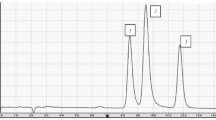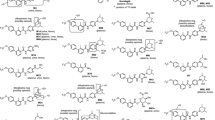Summary
A new radioimmunoassay (RIA) for the specific measurement of dihydroergotamine (DHE), sufficiently sensitive for the determination of low plasma concentrations, has been used to investigate the pharmacokinetics of unchanged DHE. In a randomized crossover trial, eight healthy male volunteers received single doses of DHE 5 mg, 10 mg and 20 mg orally and 0.1 mg and 0.5 mg intravenously. It was possible to determine plasma concentrations and urinary excretion of DHE over the following 48 h. A long terminal plasma elimination phase of unchanged DHE (half-life 15 h) was found. A similar terminal elimination half-life was also calculated from urine data. The multi-exponential decline in plasma DHE with a long terminal half-life suggests that distribution into a deep compartment contributes to the long-lasting effect of the drug. Plasma protein binding was 93%. Despite extensive tissue distribution (Vz=33 l/kg) and a high plasma clearance (CLP=2l/min), dose-independent linear pharmacokinetics was observed. The present assay was at least 20-times more specific than the polyvalent RIA used previously and appears suitable to explore the pharmacokinetics of unchanged DHE in patients on low-dose therapy. The long terminal elimination half-life of DHE only reported previously in studies using 3H-labelled drug, and considered to be due to metabolites, was also true for the parent compound. This, in addition to the sustained pharmacological activity of the 8′-hydroxy metabolite already shown, provides a further explanation for the long duration of action of DHE in animals and man.
Similar content being viewed by others
References
Clark B, Chu D, Aellig WH (1978) Actions on the heart and circulation. In: Berde B, Schild HO (eds) Handbook of Experimental Pharmacology, vol 49. “Ergot alkaloids and related compounds.” Springer, Berlin Heidelberg New York, pp 321–420
Müller-Schweinitzer E, Rosenthaler J (1987) Dihydroergotamine: pharmacokinetics, pharmacodynamics and mechanism of vasoconstrictor action in beagle dogs. J Cardiovasc Pharmacol 9: 686–693
Mellander S, Nordenfelt I (1970) Comparative effects of dihydroergotamine and noradrenaline on resistance, exchange and capacitance functions in the peripheral circulation. Clin Sci 39: 183–201
Aellig WH (1974) Venoconstrictor effect of dihydroergotamine in superficial hand veins. Eur J Clin Pharmacol 7: 137–139
Aellig WH, Berde B (1969) Studies on the effect of natural and synthetic polypeptide type ergot compounds on a peripheral vascular bed. Br J Pharmacol 36: 561–570
Krüger K, Neff K (1973) Dihydroergotamine (Dihydergot®) in the treatment of orthostatic circulatory disorders: a double blind comparison with placebo. J Med 4: 106–117
Jennings GL, Esler M, Holmes R (1979) Treatment of orthostatic hypotension with dihydroergotamine. Br Med J 2: 307
Kakkar VV, Stamatakis JD, Bentley PG, Lawrence D, Haas HA de, Ward VP (1979) Prophylaxis for postoperative deep-vein thrombosis. Synergistic effect of heparin and dihydroergotamine. JAMA 241: 39–42
Müller-Schweinitzer E (1984) What is known about the action of dihydroergotamine on the vasculature in man? Int J Clin Pharmacol Ther Toxicol 22: 677–682
Aellig WH (1981) A new technique for recording compliance of human hand veins. Br J Clin Pharmacol 11: 237–243
Aellig WH (1990) Superficial hand and foot veins show no difference in sensitivity to constrictor agents. Clin Pharmacol Ther 48: 96–101
Bobik A, Jennings GL, Skews H, Esler M, McLean A (1981) Low oral bioavailability of dihydroergotamine and first-pass extraction in patients with orthostatic hypotension. Clin Pharmacol Ther 30: 673–679
Aellig WH, Nüesch E (1977) Comparative pharmacokinetic investigations with tritium-labelled ergot alkaloids after oral and intravenous administration in man. Int J Clin Pharmacol 15: 106–112
Little PJ, Jennings GL, Skews H, Bobik A (1982) Bioavailability of dihydroergotamine in man. Br J Clin Pharmacol 13: 785–790
Schran HF, Bitz DW, DiSerio FJ, Hirsch J (1983) The pharmacokinetics and bioavailability of subcutaneously administered dihydroergotamine and dihydroergotamine-heparin combination. Thromb Res 31: 51–67
Hilke H, Kanto J, Mäntylä R, Kleimola T, Syvalahti E (1978) Dihydroergotamine: pharmacokinetics and usefulness in spinal anaesthesia. Acta Anaesth Scand 22: 215–220
Rosenthaler J, Munzer H, Voges R, Andres H, Gull P, Bollinger G (1984) Immunoassay of ergotamine and dihydroergotamine using a common 3H-labelled ligand as tracer for specific antibody and means to overcome experienced pitfalls. Int J Nucl Med Biol 11: 85–89
Lemaire M, Tillement JP (1982) Role of lipoproteins and erythrocytes in the in vivo binding and distribution of cyclosporin A in blood. J Pharm Pharmacol 34: 715–718
Eckert H, Kiechel JR, Rosenthaler J, Schmidt R, Schreier E (1978) Biopharmaceutical aspects: analytical methods, pharmacokinetics, metabolism and bioavailability. In: Berde B, Schild HO (eds) Handbook of experimental pharmacology, vol 49. “Ergot alkaloids and related compounds.” Springer, Berlin Heidelberg New York, pp 719–803
SAAM/CONSAM Computer programs (1978) USPHS/NIH/NHLBI-NCI joint development project. Department of Health and Human Services Laboratory of Mathematical Biology. Bethesda, MD 20892, USA
Gibaldi M, Perrier D (1982) Pharmacokinetics. Drugs and the pharmaceutical sciences, vol 15. Marcel Dekker, New York
Kanto J (1983) Clinical pharmacokinetics of ergotamine, dihydroergotamine, ergotoxine, bromocriptine, methysergide and lergotrile. Int J Clin Pharmacol Ther Toxicol 21: 135–142
Humbert H, Denouel J, Chervet JP, Lavene D, Kiechel JR (1987) Determination of sub-nanogram amounts of dihydroergotamine in plasma and urine using liquid chromatography and fluorimetric detection with off-line and on-line solid-phase drug enrichment. J Chromatogr 417: 319–329
Meier J, Schreier E (1976) Human plasma levels of some antimigraine drugs. Headache 16: 96–104
Maurer G, Frick W (1984) Elucidation of the structure and receptor binding studies of the major primary metabolite of dihydroergotamine in man. Eur J Clin Pharmacol 26: 463–470
Müller-Schweinitzer E, Rosenthaler J (1983) Ex vivo studies after oral treatment of the beagle with dihydroergotamine. Eur J Pharmacol 89: 1–8
Jansen W, Enghofer E, Seibel K (1983) Einmalige Gabe von Dihydroergotamin pro Tag ausreichend? MMW 125: 498–502
Leskow P, Neiss A (1984) Ergomimet Depot zur Behandlung hypotoner und orthostatischer Dysregulationen infolge Psychopharmaka. Therapiewoche 34: 2000–2008
Aellig WH (1984) Investigation of the venoconstrictor effects of 8′-hydroxy-dihydroergotamine — the main metabolite of dihydroergotamine — in man. Eur J Clin Pharmacol 26: 239–242
Benet LZ, Sheiner LB (1985) Pharmacokinetics: The dynamics of drug absorption, distribution and elimination. In: Gilman AG, Goodman LS, Rall TW, Murad F (eds) The pharmacological basis of therapeutics. Macmillan, New York, pp 3–34
Ibraheem J (1985) Pharmacokinetics of ergotamine with special emphasis on bioavailability. Doctoral thesis, Faculty of pharmacy, Uppsala University, Uppsala, Sweden
Tfelt-Hansen P, Kanshup I-L, Christensen NJ, Winkler K (1983) General and regional haemodynamic effects of intravenous ergotamine in man. Clin Sci 65: 599–604
Stürmer E (1984) Pharmakologische und pharmakokinetische Betrachtungen über Dihydroergotamin unter besonderer Berücksichtigung neuer Aspekte. In: Fitscha P (Hrsg) Neuester Stand der Dihydergot-Forschung. Workshop Wien. Thieme, Stuttgart New York, S8–13
Author information
Authors and Affiliations
Rights and permissions
About this article
Cite this article
Wyss, P.A., Rosenthaler, J., Nüesch, E. et al. Pharmacokinetic investigation of oral and IV dihydroergotamine in healthy subjects. Eur J Clin Pharmacol 41, 597–602 (1991). https://doi.org/10.1007/BF00314992
Received:
Accepted:
Issue Date:
DOI: https://doi.org/10.1007/BF00314992




